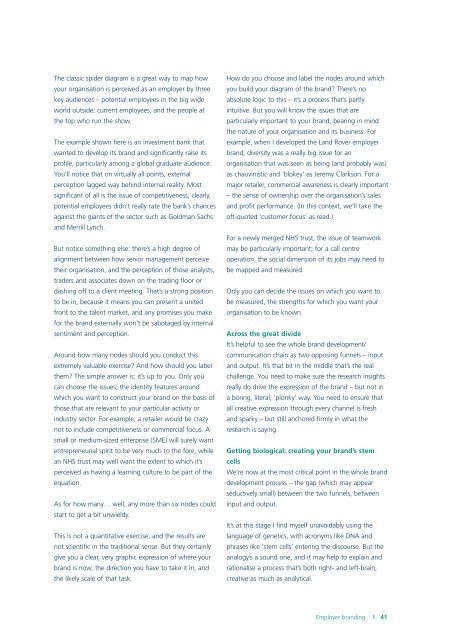Employer branding A no-nonsense approach - CIPD
Employer branding A no-nonsense approach - CIPD
Employer branding A no-nonsense approach - CIPD
Create successful ePaper yourself
Turn your PDF publications into a flip-book with our unique Google optimized e-Paper software.
The classic spider diagram is a great way to map how<br />
your organisation is perceived as an employer by three<br />
key audiences – potential employees in the big wide<br />
world outside; current employees; and the people at<br />
the top who run the show.<br />
The example shown here is an investment bank that<br />
wanted to develop its brand and significantly raise its<br />
profile, particularly among a global graduate audience.<br />
You’ll <strong>no</strong>tice that on virtually all points, external<br />
perception lagged way behind internal reality. Most<br />
significant of all is the issue of competitiveness; clearly,<br />
potential employees didn’t really rate the bank’s chances<br />
against the giants of the sector such as Goldman Sachs<br />
and Merrill Lynch.<br />
But <strong>no</strong>tice something else: there’s a high degree of<br />
alignment between how senior management perceive<br />
their organisation, and the perception of those analysts,<br />
traders and associates down on the trading floor or<br />
dashing off to a client meeting. That’s a strong position<br />
to be in, because it means you can present a united<br />
front to the talent market, and any promises you make<br />
for the brand externally won’t be sabotaged by internal<br />
sentiment and perception.<br />
Around how many <strong>no</strong>des should you conduct this<br />
extremely valuable exercise? And how should you label<br />
them? The simple answer is: it’s up to you. Only you<br />
can choose the issues, the identity features around<br />
which you want to construct your brand on the basis of<br />
those that are relevant to your particular activity or<br />
industry sector. For example, a retailer would be crazy<br />
<strong>no</strong>t to include competitiveness or commercial focus. A<br />
small or medium-sized enterprise (SME) will surely want<br />
entrepreneurial spirit to be very much to the fore, while<br />
an NHS trust may well want the extent to which it’s<br />
perceived as having a learning culture to be part of the<br />
equation.<br />
As for how many… well, any more than six <strong>no</strong>des could<br />
start to get a bit unwieldy.<br />
This is <strong>no</strong>t a quantitative exercise, and the results are<br />
<strong>no</strong>t scientific in the traditional sense. But they certainly<br />
give you a clear, very graphic expression of where your<br />
brand is <strong>no</strong>w, the direction you have to take it in, and<br />
the likely scale of that task.<br />
How do you choose and label the <strong>no</strong>des around which<br />
you build your diagram of the brand? There’s <strong>no</strong><br />
absolute logic to this – it’s a process that’s partly<br />
intuitive. But you will k<strong>no</strong>w the issues that are<br />
particularly important to your brand, bearing in mind<br />
the nature of your organisation and its business. For<br />
example, when I developed the Land Rover employer<br />
brand, diversity was a really big issue for an<br />
organisation that was seen as being (and probably was)<br />
as chauvinistic and ‘blokey’ as Jeremy Clarkson. For a<br />
major retailer, commercial awareness is clearly important<br />
– the sense of ownership over the organisation’s sales<br />
and profit performance. (In this context, we’ll take the<br />
oft-quoted ‘customer focus’ as read.)<br />
For a newly merged NHS trust, the issue of teamwork<br />
may be particularly important; for a call centre<br />
operation, the social dimension of its jobs may need to<br />
be mapped and measured.<br />
Only you can decide the issues on which you want to<br />
be measured, the strengths for which you want your<br />
organisation to be k<strong>no</strong>wn.<br />
Across the great divide<br />
It’s helpful to see the whole brand development/<br />
communication chain as two opposing funnels – input<br />
and output. It’s that bit in the middle that’s the real<br />
challenge. You need to make sure the research insights<br />
really do drive the expression of the brand – but <strong>no</strong>t in<br />
a boring, literal, ‘plonky’ way. You need to ensure that<br />
all creative expression through every channel is fresh<br />
and sparky – but still anchored firmly in what the<br />
research is saying.<br />
Getting biological: creating your brand’s stem<br />
cells<br />
We’re <strong>no</strong>w at the most critical point in the whole brand<br />
development process – the gap (which may appear<br />
seductively small) between the two funnels, between<br />
input and output.<br />
It’s at this stage I find myself unavoidably using the<br />
language of genetics, with acronyms like DNA and<br />
phrases like ‘stem cells’ entering the discourse. But the<br />
analogy’s a sound one, and it may help to explain and<br />
rationalise a process that’s both right- and left-brain,<br />
creative as much as analytical.<br />
<strong>Employer</strong> <strong>branding</strong>

















